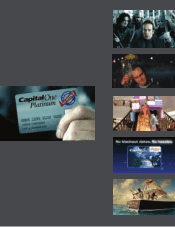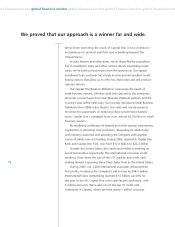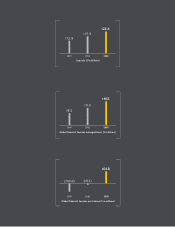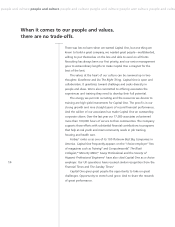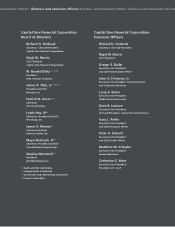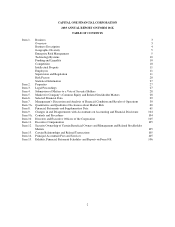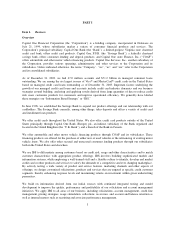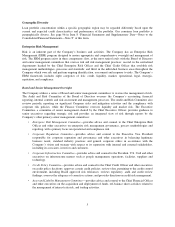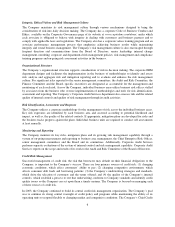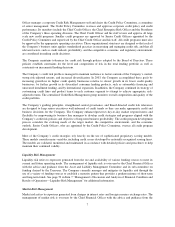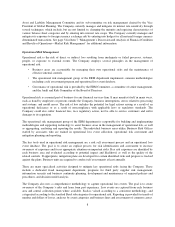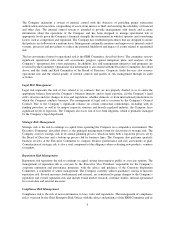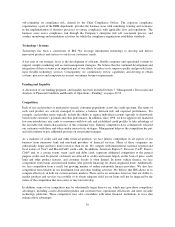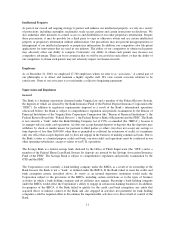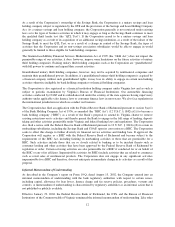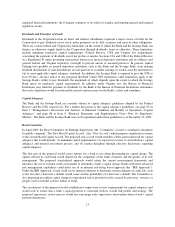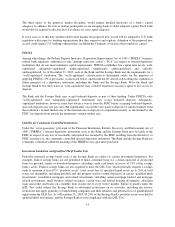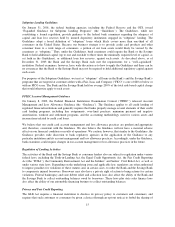Capital One 2003 Annual Report Download - page 23
Download and view the complete annual report
Please find page 23 of the 2003 Capital One annual report below. You can navigate through the pages in the report by either clicking on the pages listed below, or by using the keyword search tool below to find specific information within the annual report.Geographic Diversity
Loan portfolio concentration within a specific geographic region may be regarded differently based upon the
current and expected credit characteristics and performance of the portfolio. Our consumer loan portfolio is
geographically diverse. See page 96 in Item 8 “Financial Statements and Supplementary Data—Notes to the
Consolidated Financial Statements—Note T” of this form.
Enterprise Risk Management
Risk is an inherent part of the Company’s business and activities. The Company has an Enterprise Risk
Management (ERM) program designed to ensure appropriate and comprehensive oversight and management of
risk. The ERM program exists in three components: first, at the most senior levels with the Board of Directors
and senior management committees that oversee risk and risk management practices; second, in the centralized
departments headed by the Chief Enterprise Risk Officer and the Chief Credit Officer that establish risk
management methodologies, processes and standards; and third, in the individual business areas throughout the
Company which own risk and perform ongoing identification, assessment and response to risks. The Company’s
ERM framework includes eight categories of risk: credit, liquidity, market, operational, legal, strategic,
reputation, and compliance.
Board and Senior Management Oversight
The Company utilizes a series of Board and senior management committees to oversee the management of risk.
The Audit and Risk Committee of the Board of Directors oversees the Company’s accounting, financial
reporting, internal controls and risk assessment and management processes. The Audit and Risk Committee also
reviews periodic reporting on significant Company risks and mitigation activities and the compliance with
corporate risk policies, while the Finance Committee oversees liquidity and market risk. The Executive
Committee, a committee of senior management chaired by the Chief Executive Officer, provides guidance to
senior executives regarding strategic risk and provides an integrated view of risk through reports by the
Company’s other primary senior management committees:
•Enterprise Risk Management Committee—provides advice and counsel to the Chief Enterprise Risk
Officer and other executives on enterprise risk management governance, process methodologies and
reporting, with a primary focus on operational and compliance risk.
•Corporate Reputation Committee—provides advice and counsel to the Executive Vice President
responsible for corporate reputation and governance and other executives in balancing legitimate
business needs, standard industry practices and general corporate ethics in accordance with the
Company’s vision and strategy with respect to its reputation with internal and external stakeholders,
including its associates, investors and customers.
•Corporate Infrastructure Committee—provides advice and counsel to the President, U.S. Card and other
executives on infrastructure matters such as people management, operations, facilities, suppliers and
technology.
•Credit Policy Committee—provides advice and counsel to the Chief Credit Officer and other executives
on credit policy decisions; approves certain credit policies; reviews data pertaining to the credit control
environment, including Board approved risk tolerances; reviews regulatory, audit and credit review
findings; assesses the adequacy of corrective actions; and provides direction on credit risk management.
•Asset and Liability Management Committee—provides advice and counsel to the Chief Financial Officer
and other executives on the acquisition and deployment of funds, off-balance sheet activities related to
the management of interest rate risk, and trading activities.
5


